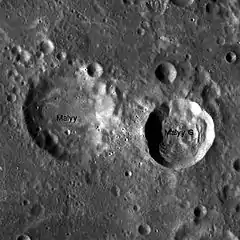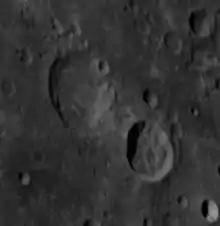 LRO image | |
| Coordinates | 21°54′N 105°18′E / 21.9°N 105.3°E |
|---|---|
| Diameter | 41 km |
| Depth | Unknown |
| Colongitude | 253° at sunrise |
| Eponym | Aleksandr L. Malyy |

Malyy is a damaged lunar impact crater that lies on the far side of the Moon, behind the eastern limb as seen from the Earth. It is located to the south-southeast of the crater Artamonov. Slightly farther to the east-northeast lies Deutsch. The quadrant of terrain to the southwest of Malyy forms a nearly level plain marked by small craters and buried features.
Several small craterlets overlap parts of the rim of Malyy, and the edge is generally eroded and uneven. The satellite crater Malyy G just to the east is much better defined, with a crisp, sharp edge, and is most likely a younger crater.
The crater is named after Aleksandr L. Malyy (Maly), Soviet rocket scientist who was one of three lead engineers and project managers overlooking the launch of Yuri Gagarin into orbit around the Earth on 1961 April 12. Malyy, a physicist and mathematician, was responsible for supervising the development of the rocket engine. He was born March 7, 1907, and died August 11, 1962.
Satellite craters
By convention these features are identified on lunar maps by placing the letter on the side of the crater midpoint that is closest to Malyy.
| Malyy | Latitude | Longitude | Diameter |
|---|---|---|---|
| G | 21.7° N | 106.9° E | 28 km |
| K | 19.6° N | 107.0° E | 15 km |
| L | 19.9° N | 106.1° E | 14 km |
References
- Andersson, L. E.; Whitaker, E. A. (1982). NASA Catalogue of Lunar Nomenclature. NASA RP-1097.
- Blue, Jennifer (July 25, 2007). "Gazetteer of Planetary Nomenclature". USGS. Retrieved 2007-08-05.
- Bussey, B.; Spudis, P. (2004). The Clementine Atlas of the Moon. New York: Cambridge University Press. ISBN 978-0-521-81528-4.
- Cocks, Elijah E.; Cocks, Josiah C. (1995). Who's Who on the Moon: A Biographical Dictionary of Lunar Nomenclature. Tudor Publishers. ISBN 978-0-936389-27-1.
- McDowell, Jonathan (July 15, 2007). "Lunar Nomenclature". Jonathan's Space Report. Retrieved 2007-10-24.
- Menzel, D. H.; Minnaert, M.; Levin, B.; Dollfus, A.; Bell, B. (1971). "Report on Lunar Nomenclature by the Working Group of Commission 17 of the IAU". Space Science Reviews. 12 (2): 136–186. Bibcode:1971SSRv...12..136M. doi:10.1007/BF00171763. S2CID 122125855.
- Moore, Patrick (2001). On the Moon. Sterling Publishing Co. ISBN 978-0-304-35469-6.
- Price, Fred W. (1988). The Moon Observer's Handbook. Cambridge University Press. ISBN 978-0-521-33500-3.
- Rükl, Antonín (1990). Atlas of the Moon. Kalmbach Books. ISBN 978-0-913135-17-4.
- Webb, Rev. T. W. (1962). Celestial Objects for Common Telescopes (6th revised ed.). Dover. ISBN 978-0-486-20917-3.
- Whitaker, Ewen A. (1999). Mapping and Naming the Moon. Cambridge University Press. ISBN 978-0-521-62248-6.
- Wlasuk, Peter T. (2000). Observing the Moon. Springer. ISBN 978-1-85233-193-1.